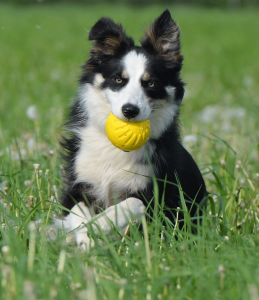What is it?
Like humans, any dog can get diabetes mellitus (sugar diabetes). And like us, it is more likely to occur in the obese than in those of a healthy weight. While the early symptoms may be subtle, it is a potentially fatal condition and can result in severe and life-threatening complications.
What causes it?
Insulin is needed in the body to tell cells to take glucose (sugar) out of the bloodstream and into the cells, where it can be used as fuel. In diabetic dogs, there is insufficient production (often coupled with peripheral insulin resistance), so the blood glucose levels rise uncontrolled. However, the body is unable to use this sugar, and instead turns to burning fats and proteins for fuel. In the short term, this is fine, but if it goes on too long, the dog is at risk of diabetic ketoacidosis, where the blood become acidic and organ systems start to shut down. This is rapidly fatal without immediate emergency treatment.
What dogs are at risk?
Any dog may develop diabetes, but it is most common in mid-adult life. Specific risk factors include pancreatitis (because of damage to the pancreas, where insulin is made), pregnancy, some infectious viral diseases, the use of high doses of steroids, Cushing’s Disease, and (most importantly) obesity. Certain breeds may be at higher risk, even when all these factors have been accounted for – there is evidence that the Miniature Pinscher, Cairn Terrier and possibly Dachshund and Poodle are at slightly increased risk.

What are the symptoms?
In the early stages, the most common symptoms are increased thirst and increased drinking (this may lead to mild urinary incontinence, especially overnight); increased hunger and weight loss (because they cannot use the sugars in their blood). Affected dogs are also prone to repeated urinary tract infections. Later, if diabetic ketoacidosis occurs, loss of appetite, lethargy, depression, dehydration, vomiting, collapse and ultimately coma and death. All dogs with diabetes, even if it is well controlled, are likely to develop cataracts as well, so it’s always worth monitoring their eyesight, or getting the vet to check it over when you come in.
How is it diagnosed?
An increased blood glucose level is highly suspicious, as is a high sugar reading in the urine. However, there are other possible causes of these signs (including stress and certain kidney diseases), so the most usual way to confirm the diagnosis of simple or early diabetes is to send away blood for a fructosamine test – this measures the AVERAGE blood glucose level over the previous 2-3 weeks. Another method is to do repeated blood sugar levels over several hours to a day – this is called a blood glucose curve, and will clearly demonstrate persistent high blood glucose levels. In Diabetic Ketoacidosis, the presence of ketones in the blood over a certain level is diagnostic – we often measure this by ketones in the urine (which is equally useful).
How can it be treated or managed?
Most diabetic dogs can be managed and stabilised effectively, but it is very unusual for it to be possible to manage them without the use of regular daily (or twice daily) injections of insulin. By giving extra insulin at exactly the correct dose, we can “top up” what they’re making, and keep their levels in the “normal” range. However, as insulin levels vary over the course of the day, and high levels can be dangerous (leading to a “hypoglycaemic episode” where the dog behaves abnormally, and may become unconscious, have fits, or even die) it is important to match the insulin dose to their feeding times. As a result, a regular, stable routine is VITAL, as is regular monitoring – with a blood glucose meter at home or blood glucose curves. Special diabetic diets also help, by smoothing out the peaks and troughs in blood sugar levels.
Can it be prevented?
The risk can be reduced by keeping your dog a healthy weight, but even healthy dogs develop diabetes, and there is no certain way to prevent it.
If you have more questions, contact your local Goddard practice!


